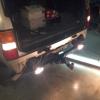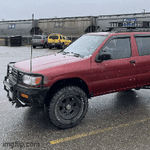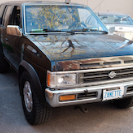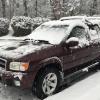-
Posts
7,201 -
Joined
-
Last visited
-
Days Won
228
Slartibartfast last won the day on May 7
Slartibartfast had the most liked content!
About Slartibartfast
- Birthday 06/14/1991
Previous Fields
-
Your Pathfinder Info
'93, mostly stock. Trying to get it reliable.
-
Mechanical Skill Level
Wrench And Socket Set Mechanic
-
Your Age
30-35
-
What do you consider yourself?
Rarely Go Off-Road
-
Model
SE
-
Year
1993
Profile Information
-
Gender
Male
-
Location
Eastern Washington
-
Country
United States
Recent Profile Visitors
Slartibartfast's Achievements

NPORA Old-Timer (5/5)
1.6k
Reputation
-
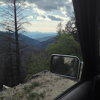
Most stubborn cylinder 1 Misfire/rough idle ever?
Slartibartfast replied to Smith's topic in 96-2004 R50 Pathfinders
The MAF is a good thought, and an easy one to check if you've got a half-decent scanner. Could explain the hard starting, too. That said, I wouldn't expect it to only cause problems on one cylinder. The service manual offers a little troubleshooting for misfire codes. Might be worth a read. Looks like you've tried most of what they suggest, though. I would follow the compression test with a leakdown test. When the head gasket let go on my neighbor's Toyota, the compression still tested fine, but when I applied shop air to #4, it bubbled out of the radiator. (I didn't have a leakdown tester at the time, so I stripped the compression tester down to just the hose, and stuck the air nozzle in the end.) It's probably not the head gasket--I don't remember anyone else on here having a head gasket let go on a VQ, and I imagine you would've mentioned if it was losing coolant--but it's still worth ruling out. When you replaced the plugs, did #1 stand out from the others? Color, deposits? Might give a clue if it's a mixture issue. When you installed the injectors, did they all go back in the same holes they came from? And did you flow-test them after cleaning them? If #1 has its original injector, untested, I would not rule it completely out yet. Are you sure what you're seeing in the exhaust is fuel? My dad's '03 burned an alarming amount of oil, especially on warm starts, though I don't remember it throwing misfire codes. Have you checked your your power valve screws? Long shot, but if one of the butterfly plates fell in, I can imagine it getting stuck in front of an intake valve or something. -

93 Nissan Terrano R3M TD27 Auto Trans Service
Slartibartfast replied to Drifter2090's topic in 90-95 WD21 Pathfinders
A friend and I did that on his Blazer. Got a bucket with measurements on it and poured in the same amount that came out each time. It would've worked better if we'd kept better track of the level in the bucket between rounds, but we got there in the end, and we didn't overfill it like I did mine. I did a bunch of work to the truck right after I got it, including the trans fluid, so I never really got a baseline for how it shifted before. After the flush, it shifts pretty well, apart from a lazy 1>2 shift under load. It hasn't gotten worse over the last 26k miles, and the transmission is still alive at 257k miles, so I'm not complaining. While you're in there, consider adding an external cooler, especially if you wheel or tow (the hotter the fluid, the faster it degrades). I also plumbed in a Magnefine external filter while I was in there. I don't know that it's doing much, but there was a little metallic shimmer in the old fluid, so I figured adding an actual filter was a good idea. -
If neither CV spins when the driveshaft spins, something is very wrong with the front diff. That said, it's an open diff, so if one hub is locked, it'll spin up the CV on the other side rather than doing anything useful. The diffs are also hell for stout on these, and surrounded by weaker components, so, unlikely failure. The fuel gauge knowing about the outside temperature is weird. Not sure which way to send you on that one. I'd probably check under the access plate in the back first (under the rear carpet), see if there's a bunch of mud around the wiring connections that's shorting them out when it's wet or something.
-
Nice find! It's been too long since I built a model kit. Funny that the box lists the engine specs like they're something special. I'm also wondering what mistranslation led to it having a "fog roof."
-

Transfer Case Module replacement
Slartibartfast replied to pathy200086's topic in 96-2004 R50 Pathfinders
Yeah, I think that's the same knob that's on the US trucks with the all-mode. Anyone here with the all-mode box want to check the numbers on your module? Long shot that the US-spec computer would be the same. -

Transfer Case Module replacement
Slartibartfast replied to pathy200086's topic in 96-2004 R50 Pathfinders
I have no idea what fits what, but I did a little more poking around. I found a whole lot of modules that start with 33084, for a bunch of different vehicles and transmissions, but none with your full PN. Looks like 33084 says what it's for, and the rest of the part number says what it fits. I couldn't find any transfer modules listed for an '00 R50, or any year R50 that I searched, which is weird. But yeah, given how many flavors there are of this thing, I'm guessing the numbers do need to match up. IMO you've got two options at this point, and both involve scouring wrecking yards. Option one, find the same-ish year R50, same engine, same transmission, same transfer case, and hope it's got the same module in it. Option two, find an R50 with the TX10A manual transfer, and grab that, the shift linkage, the center console, probably the trans tunnel plate too if they're built that way, and convert yours to a transfer case that doesn't need no stinkin' computer. I don't know for sure that having that module gone wouldn't take something else out, but if it drives around as-is, and everything else seems to work, then hopefully it won't mind. I am still assuming I know what transfer case you've got. Does the knob have an "auto" position? I haven't heard of any other transfers being used on these, but Nissan does seem to enjoy changing weird things for no apparent reason. -

Transfer Case Module replacement
Slartibartfast replied to pathy200086's topic in 96-2004 R50 Pathfinders
Oof. Yeah, that's deep! You're lucky if that module's the only thing that responded poorly. I have not heard of any other model using the ATX14A automatic transfer (which I assume is what you have, given it's got a control unit). I've seen two variants of that, one with just a heater knob on the dash for 2h/auto/4h/4l, and one with a knob or buttons for 2/auto/4 and a manual shifter for high/low. I imagine you'll need to match the donor to the control style that yours has to get the right module. The case numbers didn't get me anywhere, but might be something you can confirm against a possible replacement at the wrecking yard. Hopefully they're not coded in or something dumb like that. -
It is possible to fit the D21 sealed-beam headlights. You will need the buckets, grille, and corner/parking lights, and you'll need to change the light plugs. (It's generally recommended to build a relay harness for these rigs anyway, both to preserve the switch and to make sure the lights are getting full power.) I'm not crazy about the look, but it does open up a lot of options for better lights. I've seen people swap LED pods in place of the factory fog lights. Could be done cleanly if you can find the right size of pod. I had Hella 500FFs on my front bumper for a while. They were great when they were aimed right, but they wouldn't stay aimed right. I've got a cheap lightbar now, which does not have that issue. It's not a 1:1 replacement for the Hellas (it's more of a flood light), but it's good for spotting deer off to the sides. I've got it wired so it only works with the high beams, so I don't have to deal with two separate switches when there's oncoming traffic. For the hood vents, sounds like you're talking about something like Raptor grille lights. I haven't seen it done, but I don't see why it wouldn't work. Might be tough to make it look intentional, though. There are holes all the way through the vents, but they're about the size of coin slots, and the hole in the hood behind them rests against the rubber strip that goes over the core support. I think my door seals let in more air than the hood vents do.
-
Pretty much just R&R. The Allen bolts may fight you, mine were stuck pretty good. The service manual wants you to select new snap rings of the correct thickness to set the end-float on the CV axles (and the tension on the seals at the back of the hub), but I don't think anyone actually does that. Hawairish started a thread comparing different brands of hubs. Even the cheap-looking ones he looked at seemed pretty decent inside. The OE manual hubs are supposed to be the strongest, but good luck finding a set of those. Warns are popular. I'm running Mile Markers on mine, and apart from the chrome plating being crap, they've been great. I also posted a video in that thread (second page) from when I replaced mine, showing what's involved.
-
Looks like I was wrong about the knock sensor, and Peejay is correct--code 34 is for electrical faults only. The computer does not throw a code for actual knocking. The electrical checks for the knock sensor are pretty simple. Might as well chase those down while you're after the other three. I suspect you'll find a common fault behind all four--maybe a shared ground that's come loose/corroded, maybe harness damage. Come to think of it, the knock sensor grounds to 35M. The MAF grounds to 35M. The transistor for the coil grounds to 34M, which is right next to 35M. If those are loose/corroded/chewed, that could be three of your four codes right there. The harness diagram in the '90 manual is just this side of useless (they tried to show three different engine options in one diagram). The knock sensor diagnostics in the '95 manual show 34 and 35M near the coil, but I don't see any grounds in that neighborhood on my '93. I think 34 and 35M might be the two at the front of the upper intake, on either side of the Allen bolt, near the coolant temp sensors. Loosen, clean as needed, retighten, clear codes, see if that gets you anywhere. The injectors are grounded through the computer, so they shouldn't have anything to do with those two ground points. The same mouse might've chewed on that harness too, I guess. Or maybe the previous owner parked it because an injector was dead. Looks like your understanding of it was bang on! But here's the long version. The knock sensor is piezoelectric, similar to a guitar pickup or a microphone. It allows the computer to "listen" to the engine. If the computer "hears" pinging/knocking, it retards the ignition timing to prevent engine damage. It does not set a code when it does this. I don't know how long it waits to reset the timing back to normal afterwards. EF&EC-72 ('90 manual) says that code 34 is set when the knock sensor circuit is open or shorted. The diagnostic procedures for code 34 ('90 and '95) and P0325 ('97) are just electrical checks on the sensor and its wiring. Looks like the computer also pulls timing when that code is set. I guess it's playing it safe while it can't tell if the engine is pinging or not. The '90, '95, '97, and '03 manuals all make clear that the knock sensor is not used in normal operation. It's just there to save the engine when something else goes wrong. Sorta like a smoke detector.
-

93 Nissan Terrano R3M TD27 Auto Trans Service
Slartibartfast replied to Drifter2090's topic in 90-95 WD21 Pathfinders
I've never found a service manual for the Terrano. But one of the guys (pretty sure it was Ekim Naelcm) on the FB page made an R50 auto trans work in his Terrano, and IIRC all it took was swapping over the bellhousing and having a torque converter made, which means it's (at least a variant of) the same RE4R01A that's in the North America-spec gas-engine trucks. The '95 US manual specs 8.5 liters (9 US quarts) for the 4WD, 7.9 (8-3/8) for the 2WD. It calls for "Genuine Nissan ATF" or Dexron II. The R50 (which has an upgraded variant of the same slushbox) service manuals spec Nissan Matic D, so I assume that's what "Genuine Nissan ATF" means. I used bottom-shelf generic dex-merc in mine and it didn't seem to mind. I flushed mine by putting the cooler lines in a bucket, running the engine until it stopped pumping brown fluid into the bucket, adding fresh fluid through the dipstick tube, and repeating that process until the fluid coming out was recognizable as the fluid I was putting in. Dropping the pan looked like a PITA, and I'd been told that the filter is more of a screen than a filter anyway, so I didn't bother with it. I have since seen a picture of a trans filter full of what looked like clutch material--not sure what else was wrong with that transmission, or how common that is. Might be worth checking the filter (and wiping the sludge out of the pan) for peace of mind if nothing else. Be careful filling the transmission. The level changes a lot as it warms up, and you're supposed to check with it warm. I thought I had it close, warmed it up, and had to drain about a quart to get it back down to the mark. -
Sounds like the hubs weren't locked. The stock hubs on these are supposed to lock automatically, but they're not known for their reliability. Manual hubs are a huge upgrade and an easy mod.
-
Your best bet is the '90 manual. Free download from cardiagn.com last time I checked, or message me if you can't find it and I'll get you a link. The '94/'95 manual from Nicoclub should be close, but it's for the round-dash trucks, and there are some minor changes on those that can hang you up. The EF&EC section has a walkthrough for troubleshooting each code. I'd start with the ignition signal, injector circuit (that'll be the misfire), and MAF codes, and see if the knock sensor code goes away on its own once those three are resolved (clear the codes and see if it comes back). If the engine has no idea how much air is coming in, one cylinder isn't firing, and the timing is messed up, it may well be knocking, and annoyingly these don't have separate codes for a bad knock sensor vs actual knocking. I would also look for any obvious rodent damage. An injector circuit code could be due to a chewed wire, and my '93 had a MAF code when a rat's nest in the air filter got sucked into the MAF.
-
Looks like it'll keep you busy! Download the service manual from Nicoclub if you haven't yet, sounds like you're gonna need it.
-

02 4wd Mechanic can't find size for front u-joints
Slartibartfast replied to LoveMy02's topic in The Garage
I looked up the front U joints for an '02 on Nissanpartsdeal and found part number 37126-01G26 for the front prop shaft U joint (still available, but not cheap). They're listed for '96-'04, so there shouldn't be any mid-year-change confusion going on with the joints. Did the shop say what prevents the joints they've tried from fitting? If they just can't get the snap rings in, there's this whole thing in the R50 service manual about using color-coded snap rings of varying thicknesses to set the end-play in the joint. If the snap rings are too thin, the joint will have excessive play--if they're too thick, they may not go in at all. (PD section of the service manual, free download from Nicoclub.) Unfortunately the part numbers the manual gives for the special snap rings come back as both discontinued and for a WD21 (first gen Pathy), so that's bizarre/unhelpful. But, yeah, if the snap rings are the problem, and they can source thinner ones, that might be just what it needs. If that's not it, or they can't find thinner snap rings in that size, I would look for a used shaft from a wrecker. Even if the joints are bad, maybe you'll get lucky and find that the aftermarket joints fit the new-to-you shaft better than they fit your existing one. That said, I have heard of others having vibration issues after replacing front U joints (possibly due to the situation with the snap rings), so if you find a good used assembly, I would just slap it in there and be done with it.


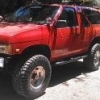



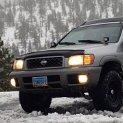
.thumb.jpg.3b55d9a307419d052e117782307fc17d.jpg)

